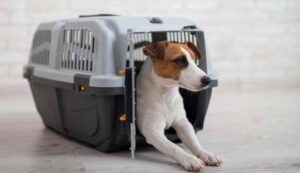
Crate training can be a game-changer for both you and your furry friend, providing them with a sense of security and comfort while offering you the peace of mind and freedom you need to enjoy life. But how do you tackle the crate training process effectively? With this step-by-step guide on how to crate train a dog, we will walk you through the essentials of crate training a dog, from choosing the perfect crate to addressing common challenges and establishing a successful routine.
Key Takeaways
- Crate training offers many benefits for both you and your pup, including house training, preventing unwanted behaviors & reducing separation anxiety.
- Create a positive environment with warm bedding & toys to motivate successful crate training.
- With patience and dedication, most dogs can be successfully crate trained within a few weeks, rewarding for both of you!
Crate Training Advantages

Crate training your pup brings a plethora of advantages to the table. It can help with:
- House training
- Board and train dog training
- Preventing unwanted behaviors
- Providing a safe space
- Reducing separation anxiety
When done correctly, crate training can strengthen the bond between you and your pup, creating a positive and rewarding experience for both parties as you crate train a puppy.
The key lies in properly introducing your dog to their crate, ensuring that it becomes their go-to sanctuary when they need some peace or feel overwhelmed. With the right approach, your dog will gradually become accustomed to their crate, eventually not soiling it within the first few days or weeks. Now, it’s time to explore the world of crate training and learn how to ensure a successful journey for you and your dog.
House Training
Crate training can be a lifesaver when it comes to house training, as it helps dogs develop bladder and bowel control. By using a crate, your dog learns to hold their bathroom needs until they are let outside for a potty break, encouraging healthy bathroom habits.
The confined space of the crate also helps prevent accidents in the house, ensuring a clean and mess-free environment.
Board and Train Dog Training
Board and train programs, like The Collar Club Academy, can significantly benefit from crate training. Not only does it provide a safe and secure space for your dog when they are not being actively trained or supervised, but it also allows professionals to assess your dog’s behavior and provide consistent training in a controlled environment. Learning how to crate train your dog is an essential skill for both you and your furry friend.
In essence, crate training forms an integral part of a successful board and train program, facilitating your dog’s comfort and safety in their crate during expert training.
Preventing Unwanted Behaviors
Crate training can work wonders in preventing unwanted behaviors such as:
- chewing
- destructive tendencies
- excessive nipping
- jumping
By providing your dog with a safe and secure space of their own, they are less likely to engage in destructive behaviors out of boredom or stress. In addition, the crate can also help manage other problem behaviors, giving you more control over your dog’s actions and ensuring a well-behaved pup.
Safe Space
A dog crate provides a much-needed safe space for dogs to retreat to when they need a break or feel overwhelmed. Dogs have an innate desire for a den-like space, and a dog’s crate can fulfill this need, offering them a comfortable spot to relax and unwind.
By setting up the crate in a central room where your family spends time, your pup will feel included and secure, promoting healthy socialization and reducing feelings of isolation.
Reducing Separation Anxiety
Crate training can play a significant role in reducing separation anxiety in dogs. By providing your dog with a familiar and secure environment, the crate can help them feel more at ease when they are alone. This sense of security can alleviate feelings of anxiety, making your dog more comfortable when left alone and less likely to act out due to stress.
Choosing the Perfect Crate

For successful crate training, selecting the right crate that aligns with your dog’s needs and preferences is imperative. There are three main types of crates to consider: wire crates, plastic crates, and mesh crates. Each type of crate has its own advantages and disadvantages, so it’s crucial to weigh the pros and cons before making a decision.
Understanding the differences between these crate types will help you make an informed choice, ensuring your dog’s comfort and safety while promoting successful crate training. Let’s examine each type of crate and delve into their respective benefits.
Wire Crates
Wire crates are popular among dog owners due to their excellent ventilation and visibility. Made from metal or wire mesh panels, these crates are incredibly strong and reliable. However, they may not provide as much privacy or insulation as other crate options, which can be a concern for some dogs or in specific environments.
It’s important to consider these factors when choosing a wire crate for your pup.
Plastic Crates
Plastic crates offer a more enclosed environment, providing better insulation and protection from the elements. The visibility inside a plastic puppy crate is diminished, making your pup feel even more safe and secure. Additionally, plastic crates are lightweight and easy to clean, and often come with added features like carrying handles.
However, the limited visibility and ventilation may not be ideal for all dogs, so consider your dog’s needs before opting for a plastic crate.
Mesh Crates
Mesh crates are lightweight and portable, making them an excellent option for small breed dogs or for travel. The mesh fabric provides optimal ventilation and allows your pup to see their environment, which can help them feel more secure. However, mesh crates may not be as durable or secure as other options, as some dogs might try to escape or chew through the material.
Keep your dog’s tendencies in mind when selecting a mesh crate.
Setting Up the Crate
After selecting the most suitable crate for your dog, proper setup becomes the next crucial step to promote their comfort and safety. By placing the crate in a central room, creating a comfortable environment, and ensuring safety, you’ll be well on your way to successful crate training.
Taking the time to create a welcoming and secure space for your dog will help them feel more at ease in their crate, making the crate training process smoother for both you and your pup.
Central Room Placement
A central room placement is crucial when setting up your dog’s crate. This location will help your pup feel included in the family’s activities and avoid feelings of isolation or exclusion. Good placement options include the living room, family room, or kitchen.
By placing the crate in a central room, you’ll encourage socialization and help your dog feel more secure and comfortable.
Comfortable Environment
To create a comfortable environment for your dog, make sure to provide them with soft bedding, such as a warm blanket or a small pillow. In addition, provide toys and treats to help them feel more at ease and entertained while in the crate. Ensuring a cozy and inviting environment will help your dog associate the crate with positive experiences and encourage them to enter willingly.
Ensuring Safety
Safety should always be a top priority when setting up your dog’s crate. Inspect the crate thoroughly for any sharp edges, corners, or loose parts that could harm your furry friend. Make sure there are no exposed screws, sharp plastic edges, or pokey wires inside the crate.
Taking these precautions will help ensure that pet parents can keep their young puppies safe and secure while enjoying their new space.
Introducing Your Dog to the Crate
The introduction of your dog to the crate marks a significant step in the crate training process. It’s essential to create a positive and rewarding experience for your pup, ensuring that they associate the crate with comfort and security. To achieve this, you can use treats and toys, patience and encouragement, and avoid any use of force.
By following these methods, you’ll help your dog feel more comfortable and relaxed in their crate, setting the stage for successful crate training.
Treats and Toys
Entice your dog to explore the crate by using treats and toys. Scatter bits of food or small treats around the front of the crate, as well as inside it, to encourage them to enter. You can also use interactive toys, such as puzzle feeders or Kong toys filled with treats, to make the crate more appealing and engaging for your pup.
By incorporating treats and toys in the crate, you’ll create positive associations and motivate your dog to enter willingly.
Patience and Encouragement
Be patient and encouraging as you introduce your dog to the crate. Allow them to explore the crate at their own pace, rewarding them with praise and treats for each small step they take towards entering the crate. It’s essential never to force your dog into the crate, as this can create fear and anxiety.
With love, patience, and understanding, your dog will soon come to love their crate and feel comfortable spending time in it, even if the dog briefly hesitates at first.
Avoiding Force
Never force your dog into the crate, as this can create fear and anxiety, making the crate training process more difficult and less effective. Instead, use positive reinforcement and encouragement to help your dog feel more comfortable and willing to enter the crate on their own.
By avoiding force and focusing on creating a positive and rewarding experience, you’ll set the stage for a successful crate training journey.
Crate Training Techniques
Having introduced your dog to the crate, the next step involves implementing crate training techniques to foster success. These techniques include using mealtimes, cue words, and gradually extending crate time. By incorporating these strategies, you’ll help your dog become more comfortable and confident in their crate, paving the way for successful crate training.
By applying these puppy crate training techniques consistently and patiently, you’ll help your dog adjust to their crate and become a well-behaved member of your family.
Mealtimes
Using mealtimes to create positive associations with the crate is an excellent technique for crate training. Here’s how to do it:
- Start by placing your dog’s food bowl near the crate.
- Gradually move the food bowl deeper inside the crate over a few days.
- This will help your dog associate the crate with something enjoyable, like mealtime.
- It will encourage them to enter the crate willingly.
As your dog becomes more comfortable eating inside the crate with the crate door open, you can close the crate door for short periods, slowly increasing the duration over time.
Cue Words
Introduce cue words like “kennel up” or “go to bed” to encourage your dog to enter the crate. When your dog follows the command and enters the crate, reward them with treats and praise, reinforcing the positive behavior. Using cue words consistently will help your dog understand and respond to these commands, making it easier to guide them into the crate and reinforce positive behavior.
Gradual Extension of Crate Time
Gradually extending crate time is an essential aspect of crate training. Here are some steps to follow:
- Start by having your dog spend a few minutes in the crate.
- Slowly increase the duration of time your dog spends in the crate.
- Be mindful of your dog’s behavior and adjust the crate time accordingly to ensure they are feeling comfortable and able to settle in the crate.
By gradually increasing crate time, you’ll help your dog build confidence and adjust to spending longer periods in their crate.
Dealing with Common Challenges
Crate training can occasionally present certain challenges like crying, barking, or accidents within the crate. By addressing these common issues, you can ensure a more successful and stress-free crate training experience for both you and your dog.
Understanding how to handle these challenges will not only make crate training more manageable but also help you build a stronger bond with your furry friend.
Crying and Barking
To address crying and barking in the crate, follow these steps:
- Ensure your dog is comfortable and has had sufficient exercise. A tired dog is less likely to exhibit these behaviors.
- Provide positive reinforcement when your dog is quiet, such as treats and praise.
- Avoid scolding or punishing them for barking or crying.
With patience and consistency, you’ll help your dog adjust to the crate and develop a more relaxed and quiet demeanor as they learn to sit quietly.
Accidents in the Crate
Prevent accidents in the crate by ensuring your dog has had ample opportunities to eliminate before crating them. If an accident does occur, clean it up with an enzymatic cleaner to remove any lingering odor and prevent your dog from returning to the same spot to relieve themselves in the future.
By addressing accidents in the crate promptly and effectively, you’ll maintain a clean and comfortable environment for your dog.
Exercise and Crate Training
Exercise holds significant importance in the successful execution of crate training. By exercising your dog before crate training, you help reduce frustration and promote relaxation, making it easier for your pup to settle into the crate.
Aim to provide your dog with 30-60 minutes of aerobic exercise before crating them to ensure they are properly prepared and more likely to relax in their crate.
Crate Training Adult Dogs
Not only puppies, but adult dogs and older dogs can also reap the benefits of crate training, albeit it might require a bit more time and patience. Just like with puppies, introducing your adult dog to the crate using treats, toys, patience, and encouragement will create a positive experience and help them feel more comfortable in their crate.
With consistency and perseverance, you can successfully crate train your adult dog and enjoy the benefits of a well-behaved companion.
Nighttime Crate Training
Nighttime crate training serves as an effective method to help your dog establish a sleep routine and offer them a safe environment for resting. Just like during the day, ensure your dog is comfortable in their crate and has had ample opportunities to eliminate before bedtime.
With patience and consistency, your dog will soon learn to associate the crate with sleep and rest peacefully throughout the night.
Crate Training Duration
While the duration of crate training can vary depending on the dog, most can be successfully crate trained within a few weeks with consistent efforts and patience. Keep in mind that each dog is different, and it’s essential to remain patient and understanding throughout the crate training process.
By following this step-by-step guide and addressing any challenges that arise, you’ll set the stage for a successful crate training experience for both you and your beloved pup.
Summary
In conclusion, crate training can provide numerous benefits for both you and your dog, from house training to reducing separation anxiety. By following this step-by-step guide and addressing common challenges, you’ll create a positive and rewarding crate training experience for your pup. With patience, consistency, and understanding, your dog will soon feel comfortable and secure in their crate, making it an invaluable tool for promoting a happy and well-behaved canine companion.
Frequently Asked Questions
What age is too late to crate train a dog?
It’s never too late to crate train your dog, as you can successfully do so at any age. While it may take some extra patience and understanding, there are a variety of ways to make the process easier for both you and your pet.
How many hours a day should I crate train my dog?
When crate training your dog, it’s important to make sure they don’t stay in the crate for longer than four to five hours at a time during the day. For puppies under 6 months of age, this should not exceed three or four hours. For adult dogs, it is recommended that they don’t stay in the crate for more than 6 hours during the day, with breaks in between as needed.
How do I get my puppy to stop whining in his crate?
To help stop your puppy from whining in his crate, provide lots of chew toys to ease teething pain, ignore the whining and don’t give him attention, and use interactive or dog treat toys to keep him busy. Additionally, place a blanket, cushion, and soft toy in the cage, make sure it is away from drafts, and get a crate that fits your puppy correctly.
Is crate training stressful for dogs?
Crate training can be stressful for dogs if done incorrectly, as they want to be with their pack leader and need plenty of exercise and interaction. Dogs with existing anxiety problems may be more likely to experience anxiety from crate training.
When should I start crate training?
Start crate training your puppy as soon as they join your family – around 8 weeks of age. Be sure to gradually increase their time spent in the cage as they grow so they become comfortable with it and it becomes a regular part of their life.




